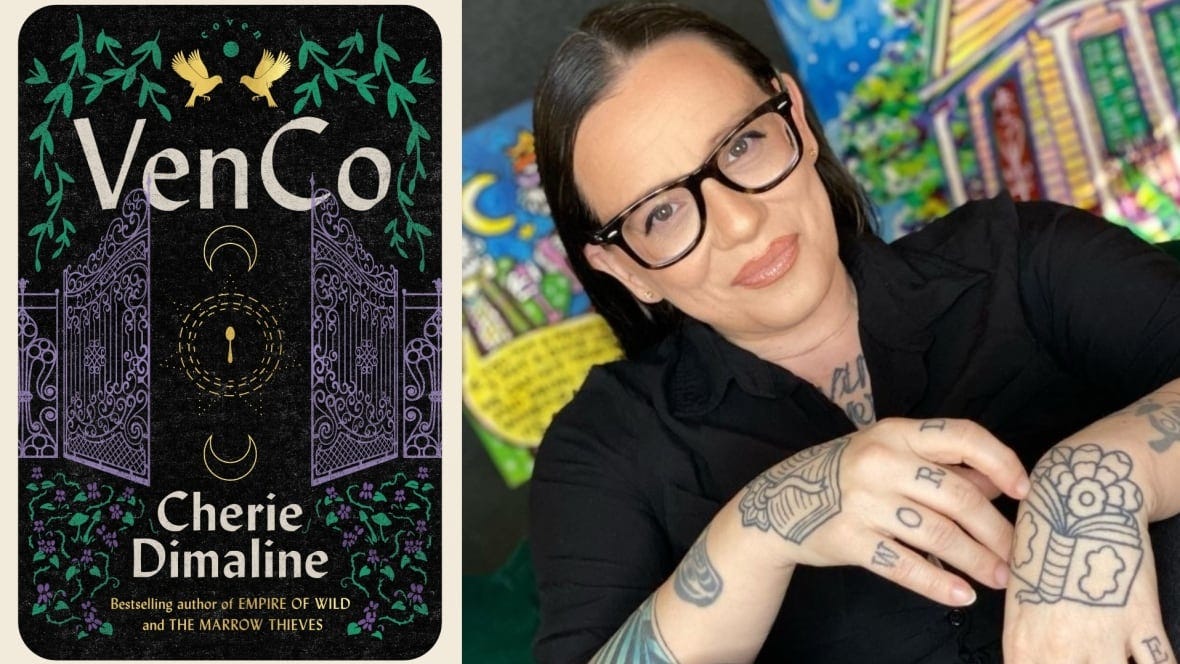🌿 Witches Unite: A Journey of Indigenous Empowerment, "VenCo" Book Review
Explore how a magical coven stands as a powerful force against capitalism and patriarchy in "VenCo."
😽 Keepin’ It Simple Summary for Younger Readers
👧🏾✊🏾👦🏾
In "VenCo," witches 🧙♀️ aren't just magic users; they are revolutionary figures fighting against injustice ✊. The story follows Lucky St. James, a young woman who discovers a silver spoon 🥄 connected to a witchy legacy. By gathering a coven, they aim to reclaim their history 📜 and challenge oppressive systems 🔄. The book is a fascinating mix of math ➗, magic ✨, and messages about solidarity 🤝 and power 💪, making it a powerful read about coming together to change the world 🌍.
🗝️ Takeaways
📖 Narrative Power: "VenCo" reclaims witch narratives to tell stories of Indigenous resistance.
🧹 Witch Empowerment: In "VenCo," witches symbolize a threat to capitalist and patriarchal systems.
🌻 Fibonacci Framework: Character development mirrors the Fibonacci sequence, emphasizing collective strength.
🔥 Redefining Witch Hunts: Illuminates witch hunts as capitalist tools, not superstitious acts.
🌿 Indigenous Roots: Story seamlessly weaves Indigenous perspectives into the fabric of its plot.
🌀 Circular Solidarity: Challenges hierarchical systems with non-linear, circular models of power.
⌛ Timeless Resistance: Explores non-linear time, where past and present resistance coexist.
Brewing Revolution: How "VenCo" Reclaims Witch Narratives as Indigenous Resistance
By Maextro Morales, Three Sonorans Reviews
This morning, as steam rose from my cafecito and corn stalks rustled alongside beans and squash in my Three Sisters Garden, I finished the final pages of Cherie Dimaline's "VenCo" with the kind of satisfaction that comes from witnessing a long-silenced truth finally spoken aloud.
As a librarian who once navigated the precise patterns of mathematical theory before finding my home among books that tell our stories, I recognize the elegant equation Dimaline has constructed: women + solidarity = power that threatens systems of oppression.
The Alchemy of Story and Resistance
"VenCo" follows Lucky St. James, a young Métis woman struggling in Toronto while caring for her grandmother Stella. When Lucky discovers a mysterious silver spoon engraved with "Salem," she's drawn into a centuries-old quest to assemble a coven of seven witches operating under the corporate front of VenCo. Each witch, identified by her connection to an enchanted Salem Witch Spoon, represents a vital variable in an equation of power designed to restore balance to systems carefully calculated to maintain patriarchal dominance.
What emerges through Dimaline's narrative is a mathematically precise deconstruction of witch hunts as economic algorithms rather than religious aberrations. The original equation was devastatingly simple: eliminate women with knowledge = secure capitalist accumulation.
Dimaline's revolutionary recalculation reveals a more potent formula: reclaimed knowledge + women's solidarity = systemic transformation.
A Fibonacci Sequence of Characters
The character development in "VenCo" follows patterns reminiscent of the Fibonacci sequence—each woman's strength builds upon and magnifies the others in an ever-expanding spiral of power:
Lucky St. James: Our entry point character whose fierce love for her grandmother provides the initial value in the sequence
Stella: The second value, whose fading memory holds crucial fragments of ancestral algorithms
Meena Good: The sum of previous values, embodying centuries of calculated resistance
Freya, Morticia, and Lettie: Continuing the exponential growth pattern with their unique variables and coefficients of power
This mathematical progression creates a compelling narrative structure that illustrates how women's collective strength multiplies rather than merely adds—a key principle in understanding both spiral patterns in nature and revolutionary movements throughout history.
Reframing the Witch Hunt Narrative
As an Indigenous person who understands how colonial systems deliberately misrepresent our histories, what resonated most powerfully is how Dimaline reconfigures the witch narrative. Through the character of Meena Good, the novel presents a transformative perspective:
"Witches were never capitalists. We were the thing that stood in the way of capitalism, which is just the engine of the patriarchy, after all. Witches were not all killed by fire. We are the fire."
This passage illuminates how women who wielded power—mainly through healing knowledge, connection to the land, and community organization—represented an existential threat to emerging capitalist structures that required control over bodies, resources, and labor.
The persecution of "witches" wasn't about superstition; it was about eliminating alternative models of power that centered communal well-being over individual accumulation.
The parallels to Indigenous women's experiences are unmistakable. Our curanderas, medicine women, and knowledge keepers have long been demonized; their practices were criminalized precisely because they represent sustainable alternatives to extraction-based economies.
Indigenous Threads in the Tapestry
Dimaline, who is Métis, weaves her Indigenous perspective throughout the narrative with a subtle but profound impact. The protagonist Lucky's Métis heritage informs her resilience and perspective, while Wendy Kiwenzie, Meena Good's wife, brings her Anishinaabe knowledge to the coven's work.
What struck me most about these inclusions is how naturally they fit within the larger tapestry of resistance. Indigenous worldviews aren't tokenized but integrated as essential perspectives on how power can be redistributed. The novel's emphasis on intergenerational knowledge and oral tradition—particularly through the characters of Stella and Lettie—echoes the ways Indigenous communities have preserved wisdom even through generations of attempted erasure.
Women's Collective Power
"VenCo" most brilliantly succeeds in showing how women's solidarity across differences—age, race, class, and cultural background—creates a formidable force. The coven members, each with their distinct histories and abilities, demonstrate how diversity strengthens rather than dilutes collective action.
This vision of solidarity feels especially vital in our current moment. As I observe the struggles of the women in my community—Indigenous and otherwise—I see how systems of oppression rely on our isolation. "VenCo offers a magical but deeply political vision of what becomes possible when we recognize our shared interest in dismantling structures that would separate us.
Geometric Patterns of Solidarity
"The Circle Is the Strongest Shape," declares one chapter title, and indeed, the novel's structural emphasis on circular, non-hierarchical power reflects indigenous approaches to community organization. Where colonial systems impose linear hierarchies and pyramidal structures, Dimaline illustrates how women's collective power functions as a circle—a perfect geometric form where each point is equidistant from the center and connected to all others.
This geometric understanding of solidarity feels particularly resonant in our current fragmented social landscape. The novel suggests that women's power to challenge capitalism lies not in individual resistance but in recreating circles of mutual support—the very geometric patterns that witch hunts sought to disrupt by isolating and eliminating key points in the circle.
Calculus of Memory and Time
Throughout "VenCo," Dimaline employs a temporal calculus that reflects Indigenous understandings of non-linear time. Lucky's dream journey to 17th-century Salem reveals how past and present exist in continuous integration and how ancestral trauma and resistance accumulate in our bodies across generations.
This temporal complexity reminds me of integral calculus—the mathematical exploration of accumulated change. The novel suggests that women's power, though suppressed at various historical points, has been accumulating beneath the surface, with its derivative function waiting to emerge when critical variables align.
As I teach my library patrons about our community's history, I often emphasize how Indigenous time operates through these cyclical functions rather than linear equations. "VenCo" captures this perfectly in the way ancestral knowledge resurfaces through Stella's fragmented memories and Lucky's dreams—proving that what seems forgotten is merely temporarily undefined in the equation.
A Literary Ceremony of Reclamation
Dimaline's prose carries the rhythm of storytelling that honors Indigenous oral traditions while deploying contemporary sharpness. The narrative balances mystical elements with grounded emotional realities—Lucky's care for her grandmother Stella provides an anchor of tenderness amid magical battles.
The novel doesn't shy away from acknowledging historical trauma but refuses to center the story of oppression. Instead, like the most powerful ceremony, it focuses on healing, reclamation, and the future possibilities that emerge when suppressed knowledge is restored.
Conclusion: Seeds of Revolution
As I closed "VenCo" and looked out at my Three Sisters Garden—where corn, beans, and squash support each other in mutual growth—I thought about how Dimaline's novel plants seeds of revolutionary thinking disguised as entertaining contemporary fantasy.
Just as Indigenous agricultural practices contain sophisticated scientific knowledge beneath seemingly simple practices, "VenCo" delivers complex political analysis through engaging storytelling.
For readers seeking a powerful reframing of witch narratives, Indigenous perspectives on resistance, or simply a compelling tale of women finding their power, "VenCo" delivers with mathematical precision and poetic heart. Dimaline has created not just a novel but a grimoire of collective liberation—one that helps us reclaim our histories and imagine new futures where women's power flourishes not despite our differences but because of them.
Maextro Morales reviews books while tending to his Three Sisters Garden in Southern Arizona. A former mathematics faculty member and current librarian, he brings both analytical precision and community perspective to his critical analysis.







